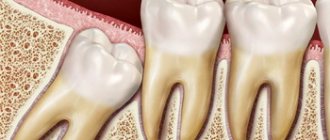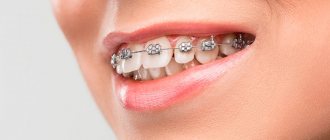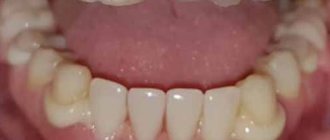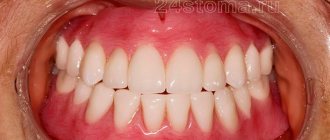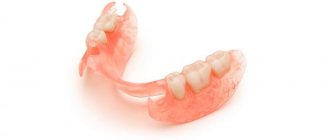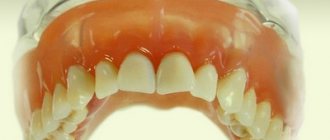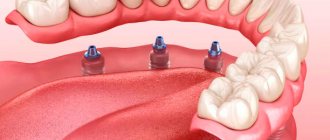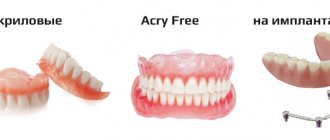Poor fixation of removable dentures is one of the common problems faced by patients. Despite the fact that orthopedists have come up with options for reliable fastening of the structure in the oral cavity, a universal method suitable for everyone without exception has not appeared.
There are several options for the instability of prostheses - immediately after installation and after some time of use. Initial instability is a consequence of improperly selected removable dentures and adjustment of the product to the alveolar process.
Solution
In many cases, the doctor can immediately determine that the patient’s removable denture will not hold. Then they choose another type of fastening - non-removable or conditionally removable (removable only by the dentist). This could be, for example, a bridge.
If you still choose a removable prosthesis, since there are contraindications for a fixed prosthesis, then another option is needed.
One of the methods
get rid of the problem - fastening with adhesive gel. The most popular of them is “Korega”. It will relieve the fear of the prosthesis falling out and the constant psychological discomfort associated with it. But it can also bring some inconvenience. For example, the need to periodically remove and apply gel. This will take time. Also, some people find it unpleasant to have a sticky substance in their mouth. But you can get used to it over time. Although rare, allergic reactions do occur. This is a complete contraindication to the use of the gel.
Second exit
– relining of the prosthesis. Over time, the bone tissue underneath the gum atrophies. Therefore, the structure does not fit so tightly. The denture must be sent to a dental laboratory for alteration. Then it will begin to stand normally in the mouth again without falling out.
Another radical solution
– implantation of two or more implants with ball heads. They fix the prosthesis, but at the same time it remains removable. This option allows you to forget about the artificial jaw falling out of your mouth. In this case, there will be no discomfort associated with the use of the adhesive gel. You won't have to spread it on your gums every time and add it throughout the day. There will be no need to experience discomfort due to the presence of a sticky substance in your mouth.
Consequences of loose dentures
Failure to see a doctor in a timely manner to correct the problem can cause serious complications that become more noticeable to others:
- Rubbing and injury to periodontal tissues, leading to inflammatory processes and periodontitis;
- discomfort while eating;
- distorted speech;
- change in facial proportions;
- Gastrointestinal diseases associated with poor chewing of food.
In addition, delaying a visit to the dentist can provoke the appearance of purulent abscesses, which subsequently require surgical intervention.
How to manage without dentures?
Alas, you cannot do without prosthetics. The loss of even one tooth disrupts the harmony in the oral cavity. In place of a lost tooth, the skin becomes less elastic, the correct oval of the face is lost over time, and signs of aging appear. The load on the remaining teeth increases. The jaw bone becomes thinner and the gum structure changes.
After tooth extraction, less blood flows into this area of tissue, and the number of blood vessels in the area where the tooth is missing decreases. As a result, the structure of the jaw bone is disrupted. All these processes then lead to displacement of the dentition, to an incorrect bite. And this, in turn, affects the quality of chewing food and disrupts the digestion process.
Even a person’s speech is impaired. Due to the absence of individual teeth, it is impossible to pronounce some sounds correctly. Especially if the problem affects the front teeth. Moreover, the absence of the front row of teeth leads to changes in the nasolabial fold. It lengthens, the corners of the mouth droop, and the person begins to look older than his age.
Why does the bridge prosthesis wobble in the mouth - reasons for mobility and how to deal with them?
A bridge is a type of permanent prosthetics supported by your teeth or implants. The supports can be living teeth, pulpless teeth, previously prosthetic teeth, the number of supporting teeth or implants from 2 or more.
The reasons for the mobility of bridges can be different.
The main reason is the mobility of the supporting teeth themselves, which could have existed before the fixation of the bridge prosthesis; mobility may appear during the process of wearing the bridge prosthesis; this occurs due to overload or improper load on the entire prosthesis, that is, a violation of occlusion, malocclusion, which forces all teeth to be overloaded , bad habits of the patient, that is, pathological stress, bruxism (teeth grinding).
Another reason may be a violation of the properties of the fixing cement, due to this, mobility may appear, that is, the cause is decementation. It is also worth noting the period of wearing the prosthesis, that is, if the teeth are under a bridge for more than 10 years, then the appearance of mobility is a normal physiological process, which will increase over the years, since each of these supporting teeth experiences additional load from the missing tooth, this is the main minus bridges. In view of this, modern dentistry tries as much as possible to avoid dental bridges and resorts to implantations. But bridges on implants are something else, since the implant is radically different from the tooth, their mobility can only appear from severe overload (incorrect occlusion) or from poorly performed implantation, as a result of which at the time of loading with their crowns, the implants already had a loss bone tissue.
There is no way to combat mobility if you only use preventive methods, namely regular check-ups with a dentist, and take periodic X-ray photographs. But if there is severe mobility of the bridge, the first thing to do is to remove it, assess the condition of the teeth visually and according to the x-ray image, and perhaps there will be a chance to save some teeth, and remove some. In this case, each clinical situation must be assessed individually. If the mobility is associated with decementation, that is, the properties of the cement have been impaired, then you can either remove and re-fix it (this is very rare), or make a new bridge. Each situation is individual, so if you have a similar situation, then you should not draw conclusions in advance; it is better to consult a dentist and hear his professional opinion.
Options for getting out of the current situation
The problem is resolved on an individual basis, taking into account the client’s personal wishes and financial capabilities. Corrective methods include: relining the structure, replacing components, implanting dentures, manufacturing a more advanced structure. Magnetic fixation, adjustment or replacement of fixation mechanisms are also often used.
An important point is that after 3-5 years, even the most expensive products need replacement or adjustment. Timely replacement is the right solution for those who want to have a wonderful smile without huge financial costs.
Recommendations for use
| Click to sign up for a FREE consultation |
The service life of each product directly depends on the source materials, operating conditions and variety. Thus, the service life of an acrylic structure is about 5 years, clasp systems - up to 10 years.
An important aspect is the storage of the prosthesis. It is recommended to store rubber products in water at night, as this prevents their deformation; more modern acrylic and nylon prostheses do not need to be removed at all (if you want to take a break from the prosthesis, the structure can be removed, cleaned and placed in a special case). If you have not worn a removable denture for a long time, it should be treated with an antiseptic before installation.
The main rule for long-term use of a removable denture is regular visits to the doctor. Don't forget to visit the dentist at least once a year.
Fixation of dentures
Powder
Pros:
- can be worn with normal or reduced salivation;
- does not change the taste of food and drinks;
- inexpensive.
Minuses:
- it is very difficult to apply the powder evenly;
- Before using the powder, the surface must be moistened;
- After application, you must wait a few minutes for the composition to swell and securely fix.
Gel
Pros:
- holds the prosthesis well;
- safe because it does not contain dyes;
- not sensitive to cold or hot food.
Minuses:
- high price;
- restriction on hot food and drinks;
- high consumption due to the liquid consistency of the gel;
- It does not fix dentures for long, so it must be constantly applied.
Cream
Pros:
- permanently fixes the prosthesis;
- safe, because it contains no toxic substances;
- has a thick consistency, and therefore a small amount is enough for good fixation;
- most often has auxiliary components that provide fresh breath.
Minuses:
- Do not allow the product to come into contact with the mucous membrane - this can lead to irritation;
- After fixation, you need to wait 15 minutes, do not eat or drink.
Spacers for fixing dentures
Pros:
- getting used to the design occurs much faster;
- can be combined with the use of other fixing agents;
- does not affect the height of the bite;
- can be used in the presence of dental deformation;
- safe and universal remedy.
Minuses:
- it costs expensive;
- An allergy may develop to the components of the pads.
Glue
Pros:
- quick adaptation to the design, can be used for temporary prostheses;
- can be used for stroke, dry mouth and neurological pathologies;
- provides fresh breath.
Minuses:
- irritation of the mucous membrane;
- With improper hygiene, the development of pathogenic flora can occur.
What to do if the denture rubs the gums?
If the prosthesis begins to rub the gums, pain and discomfort begin, you need to evaluate how intense this pain reaction is.
If these are minor pain sensations: it hurts a little, aches a little, tingles, then you can wait 2-3 days, using pharmacy ointments for pain.
If these sensations do not go away within 2-3 days, or the pain intensifies, then you need to go to the doctor who made this removable denture. The doctor will look at your jaw and in those places where the prosthesis presses too much, he will adjust it and sharpen it so that in this place the prosthesis does not press through the mucous membrane. There may be one or several such corrections, depending on the sensitivity of the patient’s mucosa. Over time, these corrections stretch from one to two to three weeks.
Reviews
Unfortunately, many removable devices, especially complete ones, have insufficient fixation, which causes great discomfort.
Some people deal with this by adapting to the situation - using fixing creams or even changing their lifestyle. Others, without delay, go to the doctor.
If you have had to adjust your dentures due to loss of stability, please share your experience with us. Leave a comment at the bottom of this page.
If you find an error, please select a piece of text and press Ctrl+Enter.
Tags dentures removable dentures
Did you like the article? stay tuned
Previous article
Review of the most popular Korean dental implants
Next article
What is the danger of blood oozing from under the crown of a tooth?
Why is this happening
The following reasons for loss are possible:
- The service life of the cement has expired, the composition has lost its fastening properties - the crown has decemented;
- The patient put too much stress on the crown by including hard foods in the menu;
- During installation, temporary cement was used, which had to be replaced at the appointed time;
- A destructive process was underway under the crown - caries developed, as a result, the tightness of the connection was broken;
- The person often consumed chewing candies and toffees - the viscous consistency of the products contributed to the tearing of the crown from the tooth;
- The crown was placed on a tooth that was too small, and the insufficient tooth height reduced the bond;
- The size of the crown exceeded the size of the stump;
- The tooth stump turned out to be pointed, so the crown was weakly fixed;
- The material used to make the prosthesis was not strong enough.
PROMOTION
Installation of crowns, dental bridge
RUB 3,450

